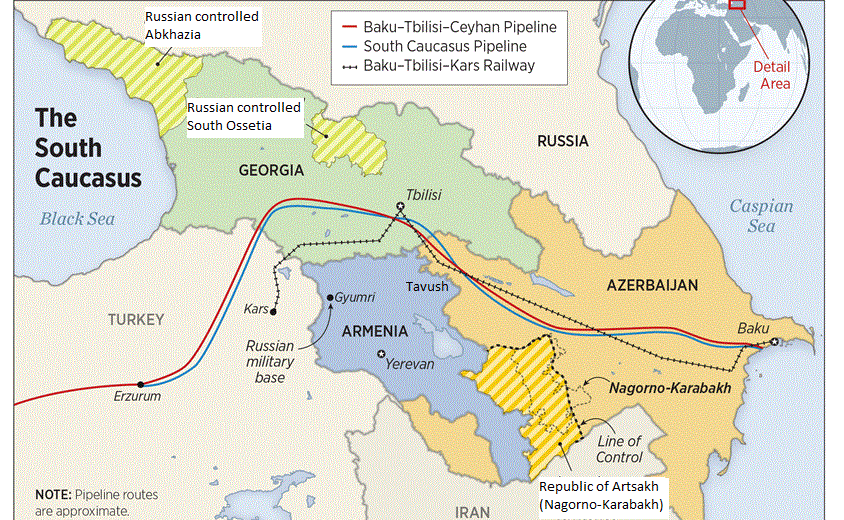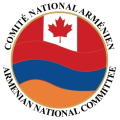The Geopolitical and Energy Security Dimensions of the Latest Armenian-Azerbaijani Clashes
- (0)

By Yeghia Tashjian
The Armenian Weekly
There are currently three major zones of possible escalations between Russia and Turkey: the Levantine zone in Syria, the Mediterranean zone in Libya, and the Caucasian zone between Armenia and Azerbaijan. All of these zones are interconnected with each other. The latest Azerbaijani provocation against Armenia must be looked at from a geopolitical and energy security dimension amid the regional struggle between Moscow and Ankara.
On July 12, 2020, Azerbaijani armed forces attempted an incursion into Armenia. Armenian military positions in that border area are based on a static defensive posture reinforced by a combination of fortified terrain and topography, thereby enjoying the strategic advantage over Azerbaijani forces. It is worth mentioning that the attack was a clear violation of the sovereignty of a recognized state and was 300 kilometers away from the borders of the Republic of Artsakh (Nagorno Karabakh). The move started with a failed attempt by Azerbaijani commandos to seize a strategic hilltop in the northeastern Armenian province of Tavush, where Armenian troops were in a defensive position. After the attack, the Armenian response intensified as the Azerbaijani army used Israeli-made drones to bomb Armenian positions. For the first time, Armenia used domestically-produced drones against Azerbaijani military targets. Azerbaijani army Major-General Polad Gashimov and Colonel Ilgar Mirzoyev and dozens of soldiers and officers were killed in Armenian retaliations. Here we should ask the following questions. What were these high level military personnel doing around the border? Was Baku preparing for a major offensive? From a military and psychological point of view, the killing of an Azerbaijani major general and his associates was a quick shock to demoralize the Azerbaijani troops on the ground and send shockwaves to Baku.
The killing of the high level officials heightened tensions and appeared to raise fears within the ruling elite and autocrats of Baku. State-sponsored protests took place in Baku calling to end the lockdown and arm the people to “liberate the occupied Azerbaijani lands”; ironically, of the 30-thousand protesters, only 150 were registered as volunteers to go to the border. President Ilham Aliyev was furious. Meanwhile, the anti-Armenian protests took a violent turn when angry protesters clashed with the police, burned their cars and stormed the parliament calling “death to Armenians.” Aliyev openly condemned the move against the parliament and portrayed it as an “attempted coup d’etat” orchestrated by the opposition. Aliyev scored two major goals: first, he showed Moscow and Western powers that his war was “popular and legitimate and he is acting on behalf of the will of the people;” and second, he wanted to eliminate the opposition by portraying them as the enemy of the state. According to Eurasianet (July 17, 2020), Baku authorities detained more than 70 activists and journalists, including seven political activists from the leading opposition “Popular Front Party of Azerbaijan” (PFPA). President Aliyev commented on the arrests saying “they are worse than Armenians… Armenians are an open enemy…While these are located among us. They get money, instructions from abroad, pollute our fresh air with stench and at these moments are standing with the enemy, not with the state.”
Aliyev’s intent was to divert the peoples’ attention from falling oil prices, unemployment, a water shortage and corruption in an attempt to get rid of his old political rivals and even traditional allies. Many Azerbaijani youths are frustrated by the diplomatic track around the Artsakh negotiations and fed up with the empty promises of the “Aliyev dynasty.” This frustration with diplomacy and mediation triggered the dismissal of Azerbaijan’s long-serving foreign minister Elmar Mammadyarov on July 16 for allegedly being too timid and weak in the negotiations. Already on July 15, Azerbaijani social media was full of attacks against the country’s “failure in diplomacy.” Mammadyarov, however, was only carrying out the orders and executing the policies of Aliyev. His replacement by Education Minister Jeihun Bayramov, who has no diplomatic experience whatsoever, further indicates that Baku will no longer adhere to diplomatic principles and will rely on the use of force to divert the peoples’ attention from socio-economic demands and mobilize the youth against Armenia. An internal power struggle that started earlier this year with a snap parliamentary election in Baku saw the elevation of a new, younger loyal elite and its replacement of the experienced “old Soviet-educated guards.” This state-sponsored transition featured the promotion of presidential assistant and former Foreign Affairs Ministry spokesman Hikmet Hajiyev to new head of the Foreign Policy Affairs department of the Presidential administration and the promotion of many loyal officials close to Vice-President Mehriban Aliyeva (President Aliyev’s wife) to new key positions.

The recruitment of these young officials further institutionalized the spread of anti-Armenianism amongst the youth. This strategy was translated on the ground in April 2020 when the “Western Azerbaijan Exiled Government” was formed in Ankara. By analyzing the Twitter posts of “Western Azerbaijan Public Union” and the “chairman of the Azerbaijani community of Nagorno-Karabakh” MP Tural Ganjaliyev, one could have assumed that the next battle was going to be with Armenia and not Artsakh. In the last few months, Azerbaijani state-sponsored social media accounts and pages unleashed extensive propaganda claiming that the territories of the Republic of Armenia also are part of “historical Azerbaijan unjustly taken away from Azeris by the Russians and given to Armenians.” Eventually, it became clear that Baku authorities were laying the groundwork to psychologically prepare their youth for the next battle as well as future battles or wars. Azerbaijan’s Pan-Turkist aspirations are not secret. Pan-Turkists believe that the territories stretching from Eastern Europe, Central Asia and some parts of Russia, Iran and China belong to their ancestors, and it is their right to reconquer these lands by arms. Amid the border clashes, the Turkish “Dirilis Postasi” outlet published a cover with a map of Artsakh and the Armenian province of Synuk and most of Vayots Dzor merged into Azerbaijan with the title “Karabakh or Death.” These aspirations are also encouraged by Turkey, where in 2019 during military drills with Azerbaijan, participants wore a badge showing the maps of Turkey and Azerbaijan as unified and depicting the regions of Ararat, Kotayk, Armavir, Aragatsotn, Shirak, Lori, Syunik, Meghri and Artsakh in Azerbaijan. The adherents of this ideology dream of the creation of a unified Turkic state extending from the Bosphorus to the Xinjiang province of China.

Coming back to geopolitics, the recent clashes may usher in a new period of unpredictability and instability and involve Turkey, Iran and Russia. The Turkish response was an immediate endorsement of Azerbaijan’s claims. With the rise of Turkey as a regional power, the balance of power in the South Caucasus and the Middle East gradually started to shift in Ankara’s favor. Turkey started to flex its muscles both through its soft and hard power engagements in Iraq, Syria, Lebanon, Libya and even Yemen. Although Ankara’s support of Baku can be seen as natural, the sudden and swift backing of Azerbaijan stems more from Ankara’s aspirations to regain its previous role as Azerbaijan’s primary military patron. According to Hurriyet Daily News (July 17, 2020), İsmail Demir, head of the Presidency of Defense Industries, after meeting with Azerbaijani Deputy Defense Minister Ramiz Tahirov and Army Commander of the “Nakhchivan Autonomous Republic” Kerem Mustafayev, announced “Turkey’s missiles, drones at Azerbaijan’s service.” Some military experts started predicting that Turkey would provide Azerbaijan with the famous Bayraktar Akıncı armed unmanned aerial vehicles (UAV). These drones proved their effectiveness in Libya and Syria against Russian-made anti-air defense systems. By doing so, Ankara would further antagonize Moscow, which has been the largest arms provider to Azerbaijan for several years.
But were all these clashes and Ankara’s enthusiasm for war a coincidence?
In June, the Nordic Monitor published reports exposing the plan of a possible Turkish invasion on Greece and Armenia. The report showed confidential slides from a PowerPoint presentation presented by the Turkish General Staff for an internal planning review. The documents were discovered in a court case file in Ankara. This military operation against Armenia was code-named “Altay.” The provocation around Tavush and Nakhichevan should be viewed from this angle too. Turkey has no military base in the South Caucasus; thus the Azerbaijani provocation against Armenia and the counter-offensive against Azerbaijani military posts by the Armenian armed forces could have been the pretext Turkey was waiting for to launch a limited offensive or strikes. If the Armenian armed forces infiltrated deep or bombed the pipelines, Turkey could have deployed its army in Nakhichevan or around Tavush under the pretext of “securing Turkey’s and Europe’s energy or national security interests.” However, Ankara and Baku failed to reach their aim since the Armenian army limited its counter-offensive and calculated the consequences of such a plan that would have driven the entire region into a war. Let’s not forget that from May 1-2, 2019, Baku and Ankara started joint tactical live-fire military exercises in Nakhichevan. According to the Defense Ministry of Azerbaijan, the joint exercises involved “troops, armored vehicles, artillery mounts and mortars, combat and transport helicopters, as well as air defense units and anti-aircraft missile units of both armies.” In the same month in 2020, Baku launched large-scale military exercises around the Artsakh frontline. In response, the Armenian army organized military drills along the border.

When it comes to energy security, it is important to mention that the Tavush area lies on major energy, railway and trade routes that link Azerbaijan, Georgia and Turkey and connect Europe to Central Asia and China without direct involvement from Russia and Iran. The location of the clashes was quite interesting. All the west-bound oil and gas pipelines and railroads pass through the same corridor, often parallel to each other and in close proximity to target areas.
What significance does the Tavush area have to Turkey and Europe with regards to energy security? First, the region is Azerbaijan’s gateway to Turkey in terms of energy, rail and transit routes. Azerbaijan’s South Caucasus Pipeline (ASCP) runs nearby, carrying gas to the Trans-Anatolian Natural Gas Pipeline (TANGP) in Turkey. These pipelines were constructed aiming to reduce Turkey’s and Europe’s gas dependence on Moscow. Moreover, the area is pivotal also to the Baku-Tbilisi-Ceyhan oil pipeline and the Baku-Tbilisi-Kars railroad, two major joint projects that Azerbaijan, Georgia and Turkey have accomplished through European support and America’s blessing. In other words, the area is crucial for Baku’s energy exports to Europe and the only land route that links Azerbaijan to Turkey via Georgia. In this context, it is also important to understand and analyze that Turkey wants to become an important energy corridor hub that bypasses Russia. By accomplishing this dream, the European Union’s (EU) politics in the future will be highly dependent on Turkish-Azerbaijani cooperation and a stable geopolitical environment (mostly in favor of Baku) in the South Caucasus.
Second, it is worth mentioning that in March and April 2020, for the first time, Azerbaijan surpassed Russia in terms of gas supplies to Turkey. For the past few years, Turkey has reduced its reliance on Russian gas imports. In 2019, for example, Russian gas accounted for 33 percent of Turkey’s gas imports, down from 52 percent in 2017, as Ankara started to diversify its energy supply roots mainly from Africa. Meanwhile, Azerbaijan played a significant role in Turkey’s energy security independence where the giant Trans-Anatolian pipeline, completed in 2019 and with an annual capacity to carry 16 billion cubic meters of Azerbaijani gas to Turkey, is being linked to southern Europe via the soon-to-be constructed Trans-Adriatic Pipeline. According to Metin Gurcan (al-Monitor, July 22, 2020), these two non-Russian pipelines passing from the vicinity of Tavush could cover about half of Turkey’s demand and 15 percent of that of Europe. The inauguration of the Baku-Tbilisi-Ceyhan pipeline in 2006 enabled Azerbaijan to export oil to international markets via the strategic port of Ceyhan on Turkey’s Mediterranean coast. Furthermore, the Baku-Tbilisi-Erzurum gas pipeline which became operational in 2017, allowed for an increase to the supply of Azeri gas to Georgia and Turkey. Now thanks to the Trans-Anatolian pipeline, Azerbaijan can sell gas to the EU and reduce the Russian giant Gazprom’s monopoly on delivering gas to the EU, hence raising eyebrows in Moscow. Turkey’s gas deal with Russia expires next year, and for this reason, little progress has been made on a renewal, which raises the prospect of deepening the Azeri-Turkish partnership after 2021. Nevertheless, even though Gazprom is likely to remain Turkey’s primary gas supplier in the near future, Ankara is trying to strengthen its bargaining position by signing maritime agreements with its allies in Western Libya and extracting gas from occupied Northern Cyprus, thus raising the prospects of regional wars in the Eastern Mediterranean with Greece and Egypt and clashing with Russia’s energy interests there.
In summary, the geopolitical pressures and the military escalation may grow around Tavush and expand towards Nakhichevan in order to attract Turkish military deployment in the South Caucasus, thus directly threatening Russian energy interests. To counter this, Armenia must play a strategic and proactive role in future energy projects in the region by accomplishing the construction of the North-South highway that connects Iran to Georgia. This highway in the future can play the role of a corridor connecting the Persian Gulf to Russia or Europe. If the EU and China realize this potential corridor is far from geopolitical risks, then it would attract foreign investment, bringing further stability and providing Yerevan a strong bargaining position in foreign policymaking and Artsakh’s conflict resolution. Finally, Armenia’s diplomatic corps must engage in proactive foreign policy when it comes to recognition of the Republic of Artsakh in European states. For Armenia, sending peaceful messages while simultaneously preparing for war is mandatory to force the autocrats of Baku to recognize the democratic and peaceful aspirations of the Armenians of the Republic of Artsakh. As the famous Latin author Publius Flavius Vegetius Renatus once said, “Si vis pacem, para bellum” (If you want peace, prepare for war).



















